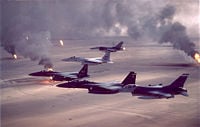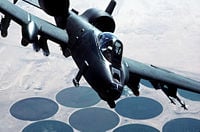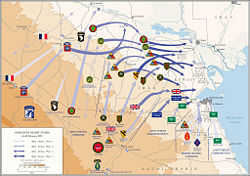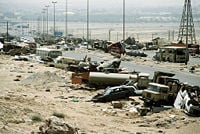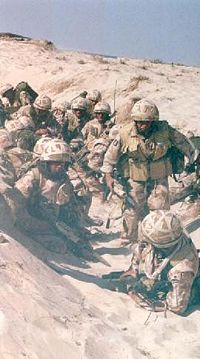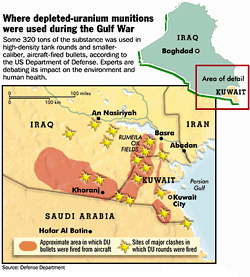Gulf War
| Gulf War | |||||||||
|---|---|---|---|---|---|---|---|---|---|
 M3 Bradley of 2nd Squadron, 4th Cavalry. 19th December 1990. | |||||||||
| |||||||||
| Combatants | |||||||||
| Commanders | |||||||||
| Strength | |||||||||
| 660,000 | 1,000,000? [Most likely 360,000] | ||||||||
| Casualties | |||||||||
| 378 dead, 1,000 wounded |
25,000 dead, 75,000 wounded | ||||||||
The Gulf War (August 28, 1990 ‚Äď February 28, 1991) was a conflict between Iraq and a coalition force of approximately 30 nations[1] led by the United States and mandated by the United Nations in order to liberate the nation of Kuwait.
The conflict is known by numerous alternative names that reflect the historical, political, and journalistic views of different groups and regions. These include Gulf War, Persian Gulf War, War in the Gulf, 1990 Gulf War, Gulf War Sr., or First Gulf War (to distinguish it from the ongoing Iraq War), Second Gulf War (to distinguish it from the Iran-Iraq War), Liberation of Kuwait, War of Kuwait, and Mother of Battles. Operation Desert Storm was the US name of the air/land operations and is often used to refer to the conflict.
The war began with the Iraqi invasion of Kuwait on August 2, 1990, following Iraqi contentions that Kuwait was illegally slant-drilling petroleum across Iraq’s border. The invasion was met with immediate economic sanctions by the United Nations against Iraq. Hostilities commenced in January 1991, resulting in a decisive victory for the coalition forces, which drove Iraqi forces out of Kuwait with minimal coalition deaths. Aerial and ground combat was confined to Iraq, Kuwait, and bordering areas of Saudi Arabia. Iraq also launched SS-1 Scud missiles against targets in Saudi Arabia and Israel. Although Saddam Hussein, Iraq's President, had been aided by the West during the Iran-Iraq War, his dictatorial regime, belligerence toward Israel, and human rights violations, increasingly led the U.S. and allies to distance themselves from Iraq.
Pre-war Iraqi-American relations
Pre Iran-Iraq war
To the U.S., Iran-Iraqi relations were stable, and Iran had been chiefly an ally of the Soviet Union. The U.S. was concerned with Iraq‚Äôs belligerence toward Israel and disapproval of moves towards peace with other Arab states. It also condemned Iraqi support for various Arab and Palestinian militant groups such as Abu Nidal, which led to its inclusion on the incipient U.S. list of state sponsors of international terrorism on December 29, 1979. The U.S. remained officially neutral during the outbreak of hostilities in the Iran-Iraq War, as it had previously been humiliated by a 444 day long Iranian hostage crisis and expected that Iran was not likely to win. In March 1982, however, Iran began a successful counteroffensive (Operation Undeniable Victory). In a bid to open the possibility of relations to Iraq, the country was removed from the list of state sponsors of terrorism. Ostensibly this was because of improvement in the regime‚Äôs record, although former United States Assistant Secretary of Defense Noel Koch later stated, "No one had any doubts about [the Iraqis'] continued involvement in terrorism‚Ķ The real reason was to help them succeed in the war against Iran."[2] With Iran's newfound success in the war and its rebuff of a peace offer in July, arms sales from other states (most importantly the Soviet Union, France, Egypt, and starting that year, China) reached a record spike in 1982, but an obstacle remained to any potential U.S.-Iraqi relationship‚ÄĒAbu Nidal continued to operate with official support in Baghdad. When the group was expelled to Syria in November 1983, the Reagan administration sent Donald Rumsfeld as a special envoy to cultivate ties.
Cooling of relations
Following the war, however, there were moves within the Congress of the United States to isolate Iraq diplomatically and economically over concerns about human rights violations, its dramatic military build-up, and hostility to Israel. Specifically, in 1988, the Senate passed the "Prevention of Genocide Act of 1988," which imposed sanctions on Iraq. The bill was not, however, adopted by the House.
Eve of the invasion
In late July, 1990, as negotiations between Iraq and Kuwait stalled, Iraq massed troops on Kuwait‚Äôs borders and summoned American Ambassador April Glaspie for an unanticipated meeting with Iraqi President Saddam Hussein. Saddam may have interpreted some comments by U.S. officials to give an invasion the green light. U.S. sources say that it had handled everything ‚Äúby the book‚ÄĚ (in accordance with the U.S.‚Äôs official neutrality on the Iraq-Kuwait issue) and had not signaled Iraqi President Saddam Hussein any approval for defying the Arab League‚Äôs Jeddah crisis squad, which had conducted the negotiations between Iraq and Kuwait. Many believe that Saddam‚Äôs expectations may have been influenced by a perception that the U.S. was not interested in the issue, for which the Glaspie transcript is merely an example and that he may have felt so in part because of U.S. support for the reunification of Germany, another act that he considered to be nothing more than the nullification of an artificial, internal border. Others, such as Kenneth Pollack, believe he had no such illusion, or that he simply underestimated the extent of American military response.
Diplomacy/Operation Desert Shield
UN Resolution
Within hours of the invasion, Kuwaiti and U.S. delegations requested a meeting of the UN Security Council, which passed UN Security Council Resolution 660, condemning the invasion and demanding a withdrawal of Iraqi troops. On August 3, the Arab League passed its own resolution demanding a withdrawal. The resolution also called for a solution to the conflict from within the League, and warned against foreign intervention. On August 6, the Security Council passed UN Security Council Resolution 661, placing economic sanctions on Iraq.
Possibility of attack on Saudi Arabia
The decision by the West to repel the Iraqi invasion had as much to do with preventing an Iraqi invasion of Saudi Arabia, a nation of far more importance to the world than Kuwait, as it did with defending Kuwait itself. The rapid success of the Iraqi army against Kuwait had brought Iraq’s army within easy striking distance of the Hama oil fields, Saudi Arabia’s most valuable resources. Iraqi control of these fields as well as Kuwaiti and Iraqi reserves would have given it a large share of the world’s oil supply, second only to Saudi Arabia itself. The United States, Europe, and Japan saw such a potential monopoly as dangerous. Saudi Arabia, a geographically large nation with dispersed population centers would have found it difficult to quickly mobilize to meet the Iraqi division deployed in Southern Kuwait. Very likely Iraq would have gained control of the Eastern oil fields but it is heavily debatable whether Iraq could have fought into the Saudi capital of Riyadh. The Iraqi armored divisions would face the same difficulties that Saudi forces were facing in order to defend the oil fields, namely to transverse large distances across inhospitable desert. This would have all occurred against the backdrop of intense bombing by the Saudi Air Force, by far the most modern arm of the Saudi military.
Iraq had a number of grievances with Saudi Arabia. The concern over debts stemming from the Iran-Iraq war was even greater when applied to Saudi Arabia, which Iraq owed some $26 billion. The long desert border was also ill-defined. Soon after his victory over Kuwait, Saddam began verbally attacking the Saudi kingdom. He argued that the American-supported country was an illegitimate guardian of the holy cities of Mecca and Medina. Saddam combined the language of the Islamist groups that had recently fought in Afghanistan with the rhetoric Iran had long used to attack the Saudis.
The addition of "Allahu Akbar" (‚ÄúGod is Great‚ÄĚ) to the flag of Iraq and images of Saddam praying in Kuwait were seen as part of a plan to win the support of the Muslim Brotherhood and detach Islamist Mujahideen from Saudi Arabia. There was further escalation of such propaganda attacks on Saudi Arabia as western troops poured into the country.
Operation Desert Shield
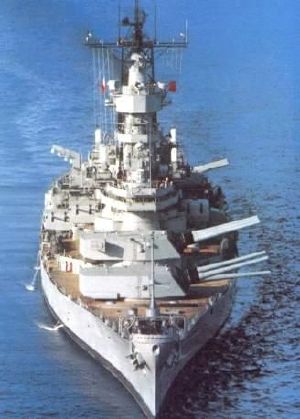
In 1980, then President Jimmy Carter issued the Carter Doctrine, which states that
"…an attempt by any outside force to gain control of the Persian Gulf region will be regarded as an assault on the vital interests of the United States of America, and such an assault will be repelled by any means necessary, including military force."
President Ronald Reagan expanded this further in 1981 by declaring that the United States would use force to protect Saudi Arabia, whose security at the time was threatened after the outbreak of the Iran-Iraq War. Acting on this authority, and out of fear the the Iraqi army could launch an invasion of Saudi Arabia, President George H. W. Bush quickly announced that the U.S. would launch a "wholly defensive" mission to prevent Iraq from invading Saudi Arabia‚ÄĒOperation Desert Shield‚ÄĒand US troops moved into Saudi Arabia on August 7 1990. On August 8, Iraq declared parts of Kuwait to be extensions of the Iraqi province of Basra and the rest to be the 19th province of Iraq.
The United States Navy mobilized two naval battle groups, the aircraft carriers USS Dwight D. Eisenhower and USS Independence and their escorts, to the area, where they were ready by August 8. 48 US Air Force F-15s from the 1st Fighter Wing at Langley Air Force Base, Virginia, landed in Saudia Arabia and immediately commenced round the clock air patrols of the Saudi-Kuwait-Iraq border areas to prevent further Iraqi advances. The U.S. also sent the battleships USS Missouri and USS Wisconsin to the region, and they would later become the last battleships to actively participate in a war. Military buildup continued from there, eventually reaching 500,000 troops. Much of the material was airlifted or carried to the staging areas via fast sealift ships, allowing a quick buildup. The consensus among military analysts is nonetheless that until October, the American military forces in the area would have been insufficient to stop an invasion of Saudi Arabia had Iraq attempted one.
Building a coalition
A long series of UN Security Council and Arab League resolutions were passed regarding the conflict. One of the most important was Resolution 678, passed on November 29, giving Iraq a withdrawal deadline of January 15, 1991, and authorizing "all necessary means to uphold and implement Resolution 660," a diplomatic formulation authorizing the use of force.
The United States, especially Secretary of State James Baker, assembled a coalition of forces to join it in opposing Iraq, consisting of forces from 34 countries: Afghanistan, Argentina, Australia, Bahrain, Bangladesh, Canada, Czechoslovakia, Denmark, Egypt, France, Germany, Greece, Hungary, Honduras, Italy, Kuwait, Morocco, The Netherlands, New Zealand, Niger, Norway, Oman, Pakistan, Poland, Portugal, Qatar, Saudi Arabia, Senegal, South Korea, Spain, Syria, Turkey, the United Arab Emirates, the United Kingdom and the United States itself. U.S. troops represented 74 percent of the coalition’s 660,000 troops in Iraq. Many of the coalition forces were reluctant to join; some felt that the war was an internal Arab affair, or feared increasing American influence in Kuwait. In the end, many nations were persuaded by Iraq’s belligerence toward other Arab states, and offers of economic aid or debt forgiveness.
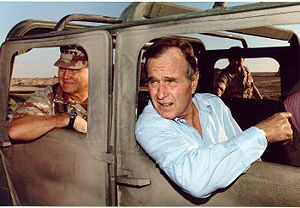
Justifying the war
The United States and the United Nations gave several public justifications for involvement in the conflict. The most important reason was the Iraqi violation of Kuwaiti territorial integrity. In addition, the United States moved quickly to support its long-time ally, Saudi Arabia, whose importance in the region and as a key supplier of oil made it of considerable geopolitical importance.
During a speech given on September 11th, 1990, George H.W. Bush stated that he thought Iraq intended to threaten Saudi Arabia from its new military position in Kuwait. Satellite photos showing a build up of Iraqi forces along the border were the supposed source of this information. Jean Heller, an investigative reporter on the St Petersburg Times decided to investigate. Satellite photos from a commercial satellite, Soyuz Karta, were obtained for around $3,000. On January 6, 1991, she wrote an article detailing what had been found, titled "Photos Don't Show Buildup.[3] The photos were reviewed by several experts and did not show any evidence to support the claims of George H.W. Bush. No buildup of troops in anywhere near the amounts stated by the President were visible in the photos.
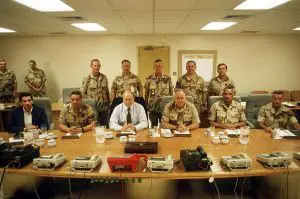
Some Americans were dissatisfied with the explanations and "No Blood For Oil" became a rallying cry for domestic opponents of the war. Later justifications for the war included Iraq’s history of human rights abuses under President Saddam Hussein. Saddam was also suspected of possessing biochemical weapons (which he later used against his own people) and was known to be attempting to build atomic bombs, providing further justification beyond his violation of Kuwaiti integrity.
The Senate supported military actions in a 52-47 vote.
Final peace proposals
Various peace proposals were floated, but none were agreed to. The United States insisted that the only acceptable terms for peace were Iraq's full, unconditional withdrawal from Kuwait. Iraq insisted that withdrawal from Kuwait must be ‚Äúlinked‚ÄĚ to a simultaneous withdrawal of Syrian troops from Lebanon and Israeli troops from the West Bank, Gaza Strip, the Golan Heights, and southern Lebanon. Morocco and Jordan were persuaded by this proposal, but Syria, Israel, and the anti-Iraq coalition denied that there was any connection to the Kuwait issue. Syria joined the coalition to expel Saddam but Israel remained officially neutral despite rocket attacks on Israeli civilians. The Bush administration persuaded Israel to remain outside the conflict with promises of increased aid, while the PLO under Yasser Arafat openly supported Saddam Hussein, leading to a later rupture in Palestinian-Kuwaiti ties and the expulsion of many Palestinians from Kuwait.
On January 12, 1991, the United States Congress authorized the use of military force to drive Iraq out of Kuwait. The votes were 52-47 in the Senate and 250-183 in the House. These were the closest margins in authorizing force by the Congress since the War of 1812. Soon after, the other states in the coalition also authorized force.
Air campaign
Main air campaign starts
A day after the deadline set in the UN resolution, the coalition launched a massive air campaign codenamed Operation Desert Storm with more than 1,000 sorties launching per day, beginning early in the morning on January 17, 1991. Five hours after the first attacks, Baghdad state radio broadcast a voice identified as Saddam Hussein declaring that ‚ÄúThe great duel, the mother of all battles has begun. The dawn of victory nears as this great showdown begins.‚ÄĚ
The Persian Gulf War is sometimes called the ‚Äúcomputer war‚ÄĚ because of the advanced weapons used in the air campaign which included precision-guided munitions (or "smart bombs"), cluster munitions, BLU-82 ‚ÄúDaisy Cutters‚ÄĚ, and cruise missiles. Iraq responded by launching 8 SCUD missiles into Israel the next day. The first priority for Coalition forces was the destruction of the Iraqi air force and anti-aircraft facilities. This was quickly achieved, and for the duration of the war, Coalition aircraft could operate largely unchallenged. Despite Iraq‚Äôs better-than-expected anti-aircraft capabilities, only one coalition aircraft was lost in the opening day of the war. F-117A stealth planes were heavily used in this phase to elude Iraq‚Äôs extensive SAM systems and anti-aircraft weapons; once these were destroyed, other types of aircraft could more safely be used. The sorties were launched mostly from Saudi Arabia and the six Coalition aircraft carrier groups in the Persian Gulf.
The next coalition targets were command and communication facilities. Saddam had closely micromanaged the Iraqi forces in the Iran-Iraq War and initiative at the lower levels was discouraged. Coalition planners hoped Iraqi resistance would quickly collapse if deprived of command and control.
Iraq's airforce escapes to Iran
The first week of the air war saw a few Iraqi sorties, but these did little damage and thirty-eight Iraqi MiGs were shot down by Coalition planes. Soon after, the Iraqi Air Force began fleeing to Iran, with between 115 to 140 aircraft flown to Iran.[4] The mass exodus of Iraqi aircraft to Iran took coalition forces by surprise and they were unable to react before most of the Iraqi aircraft had made it "safely" to Iranian airbases. Iran has never returned the aircraft to Iraq and did not release the aircrews to return home until years later. On January 23, Iraq was accused of dumping approximately 1 million tons of crude oil into the gulf, causing the largest oil spill in history. This was denied by the Iraqi government, which claimed that the allied bombing campaign had damaged and destroyed Iraqi oil tankers that were docked at the time.
Infrastructure bombing
The third and largest phase of the air campaign targeted military targets throughout Iraq and Kuwait: SCUD missile launchers, weapons of mass destruction sites, weapons research facilities, and naval forces. About one-third of Coalition air power was devoted to attacking SCUDs, which were on trucks and therefore difficult to locate. In addition, the air campaign targeted facilities useful for both the military and civilians: Electricity production facilities, nuclear reactors, telecommunications equipment, port facilities, oil refineries and distribution, railroads, and bridges. Electrical power facilities were destroyed across the country. At the end of the war, electricity production was at four percent of its pre-war levels. Bombs destroyed the utility of all major dams, most major pumping stations and many sewage treatment plants. Some U.S. and British special forces teams had been covertly inserted into western Iraq to aid in the search and destruction of SCUDs. However, the lack of adequate terrain for concealment hindered their operations, and many of them were killed or captured.
Hits on civillian facilities
In most cases, Coalition forces avoided hitting civilian-only facilities. However, on February 13, 1991, two laser-guided "smart bombs" destroyed the Amiriyah blockhouse, which the Iraqis claimed was for the auspices of an air shelter. U.S. officials claimed that the blockhouse was a military communications center, but Western reporters have been unable to find evidence for this. The White House claims, in a report titled Apparatus of Lies: Crafting Tragedy, that U.S. intelligence sources reported the blockhouse was being used for military command purposes.[5]
Iraq launches missile strikes
Iraq launched missile attacks on coalition bases in Saudi Arabia and on Israel, in the hopes of drawing Israel into the war and thus alienating other Arab states out of it. This strategy proved ineffective. Israel did not join the coalition, and all Arab states stayed in the coalition except Jordan, which remained officially neutral throughout. The SCUD missiles generally caused fairly light damage, although its potency was felt on February 25, when 28 Americans were killed when a SCUD destroyed their barracks in Dhahran. The SCUDs targeting Israel were ineffective due to the fact that increasing the range of the SCUD resulted in the dramatic reduction in accuracy and payload.
Vulnerability of Iraq against air power
On January 29, Iraq attacked and occupied the lightly-defended Saudi city of Khafji with tanks and infantry. However, the Battle of Khafji ended when Iraqis were driven back by Saudi forces supported by U.S. Marines with close air support over the following two days. Khafji was a strategic city immediately following the Iraqi invasion of Kuwait. The Iraqi reluctance to commit several armored divisions to the occupation and subsequent use of Khafji as a launching pad into the initially lightly defended Eastern portion of Saudi Arabia is considered by many academics as a grave strategic error. Not only would Iraq have secured a majority of Middle Eastern oil supplies, it would have found itself better able to threaten the subsequent U.S. deployment along superior defensive lines. The effect of the air campaign was to decimate entire Iraqi brigades deployed in the open desert in combat formation. The air campaign also prevented effective Iraqi resupply to forward deployed units engaged in combat, as well preventing the large number (450,000) of Iraqi troops from achieving the force concentration essential for victory.
Ground campaign
The coalition forces dominated the air with their technological advantages, but the ground forces were considered to be more evenly matched. However, the coalition ground forces had the significant advantage of being able to operate under the protection of coalition Air supremacy that had been achieved by the Air Forces prior to start of the main ground offensive.
Initial moves into Iraq
Elements of the 2nd Brigade, 1st Cavalry Division performed a covert recon into Iraq on February 9, 1991, followed by a recon in force on February 20, that destroyed an Iraqi battalion. On February 22, 1991, Iraq agreed to a Soviet-proposed cease-fire agreement. The agreement called for Iraq to withdraw troops to pre-invasion positions within three weeks following a total cease-fire, and called for monitoring of the cease-fire and withdrawal to be overseen by the UN Security Council. The US rejected the proposal but said that retreating Iraqi forces would not be attacked, and gave twenty-four hours for Iraq to begin withdrawing forces.
Coalition forces enter Iraq
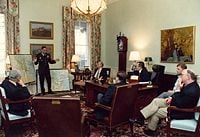
The U.S. VII Corps launched an armored attack into Iraq, just to the west of Kuwait, taking Iraqi forces by surprise. Simultaneously, the U.S. XVIII Airborne Corps launched a sweeping "left-hook" attack across the largely undefended desert of southern Iraq, led by the 3rd Armored Cavalry Regiment (3rd ACR) and the 24th Infantry Division (Mechanized). The left flank of this movement was protected by the French 6th Light Armored Division (which included units of the French Foreign Legion). The fast-moving French force quickly overcame the Iraqi 45th Infantry Division, suffering only a handful of casualties, and took up blocking positions to prevent any Iraqi force from attacking the coalition flank. The right flank of the movement was protected by the British 1st Armoured Division. Once the allies had penetrated deep into Iraqi territory, they turned eastward, launching a flank attack against the Republican Guard.
Both sides exchanged fire, but the Republican guard divisions, worn down by weeks of aerial bombardment, proved unable to withstand the Allied advance. Tank battles flared as the Republican Guard attempted to retreat. The coalition won with minimal losses.
Iraq's forces outmatched
It soon became obvious the Iraqi strategy was inherently flawed. Once Iraq had decided it was not going to advance into the eastern oil fields of Saudi Arabia, there was no reason for Iraqi forces to deploy further south from Kuwait City in great numbers. The decision to deploy significant quantities of troops along the desert border of Kuwait unnecessarily increased the length of Iraqi supply lines. Secondly, once the decision had been made to deploy along the border, the decision to extend it only slightly along the Iraqi border invited a massive flanking. Indeed, the Iraqis did not possess enough forces to maintain a long enough front along the border of Kuwait and southwestern Iraq. Therefore it was imperative that the deployment and the front should have been shortened to just South of Kuwait City and extending to the outskirts of Basra. Iraq possessed only one absolute military advantage over the coalition, that being the quality and quantity of its artillery pieces. However, most of Iraq’s artillery pieces were towed and hence not well suited to large expansive maneuvers. This also meant that it was in Iraq’s interest to slow down the movement of opposition forces and engage along lines that could not be easily broken or flanked.
The coalition advance was much swifter than U.S. generals expected. On February 26, Iraqi troops began retreating out of Kuwait, allegedly setting fire to Kuwaiti oil fields as they left (although the fact that coalition troops had to clear unexploded cluster bombs from the oil fields before the fires could be extinguished has lead some observers to suggest that the fires may have been caused by the coalition bombing campaign). A long convoy of retreating Iraqi troops formed along the main Iraq-Kuwait highway. The column also had prisoners and other fleeing Iraqi civilians such as families of Iraqi military. Controversially, this convoy was bombed so extensively by the Allies that it came to be known as the Highway of Death. Equally controversially, forces from the United States, the United Kingdom, and France continued to pursue retreating Iraqi forces over the border and back into Iraq, moving to within 150 miles (240 km) of Baghdad before withdrawing.
One hundred hours after the ground campaign started, President Bush declared a cease-fire and on February 27, declared that Kuwait had been liberated.
Post-war military analysis
Estimates of the number of Iraq troops deployed at the time ranged from 545,000 to 600,000. Subsequently, experts think that the qualitative and quantitative descriptions of the Iraqi Army at the time were exaggerated, including both temporary and auxiliary support elements. Many of the Iraqi troops were also young, under-resourced and poorly trained conscripts. Both the coalition and the Iraqi leadership had an interest in exaggerating the numbers and strength of the Iraqi forces.
The coalition committed approximately 540,000 troops. A further 100,000 Turkish troops were deployed along the common border of Turkey and Iraq, which caused significant force dilution of the Iraqi military by forcing it to deploy its forces along all its borders (except, ironically, its bitter enemy Iran). This allowed the main thrust by the Americans to not only possess a significant technological advantage but also a superiority in force numbers.
The main surprise of the ground campaign was the incredible success of Allied technology over the Soviet equipped and styled Iraqi army. This was due to the rigid Soviet style of centralized command and control that was easily disrupted and the Iraqis failing to find an effective countermeasure to the thermal sights and the sabot rounds used by the M1 Abrams and the other coalition tanks. This equipment enabled coalition tanks to effectively engage and destroy Iraqi tanks from more than three times the distance that Iraqi tanks could engage. The Iraqi forces also failed to utilize the advantage that could be gained from using urban warfare‚ÄĒfighting within Kuwait City‚ÄĒwhich could have inflicted significant casualties on the attacking forces. Urban combat reduces the range at which fighting occurs and can negate some of the technological advantage that well equipped forces enjoy.
The end of active hostilities
A peace conference was held in Iraqi territory occupied by the coalition. At the conference, Iraq won the approval of the use of armed helicopters on their side of the temporary border, ostensibly for government transit due to the damage done to civilian transportation. Soon after, these helicopters, and much of the Iraqi armed forces, were refocused toward fighting against a Shiite uprising in the south. The rebellions were encouraged on February 2, 1991, by a broadcast on CIA run radio station, The Voice of Free Iraq, broadcasting out of Saudi Arabia. The Arabic service of the Voice of America supported the uprising by stating that the rebellion was large and that they soon would be liberated from Saddam. [6]
In the North, Kurdish leaders took heart in American statements that they would support an uprising and began fighting, in the hopes of triggering a coup. However, when no American support was forthcoming, Iraqi generals remained loyal and brutally crushed the Kurdish troops. Millions of Kurds fled across the mountains to Kurdish areas of Turkey and Iran. These incidents would later result in no-fly zones being established in both the North and the South of Iraq. In Kuwait, the Emir was restored and suspected Iraqi collaborators were repressed. Eventually, over 400,000 people were expelled from the country, including a large number of Palestinians (due to their support of and collaboration with Saddam Hussein).
There was some criticism of the Bush administration for its decision to allow Saddam Hussein to remain in power, rather than pushing on to capture Baghdad and overthrow his government. In their co-written 1998 book, A World Transformed, Bush and Brent Scowcroft argued that such a course would have fractured the alliance and would have had many unnecessary political and human costs associated with it.
Instead of greater involvement of its own military, the United States hoped that Saddam would be overthrown in an internal coup. The Central Intelligence Agency used its assets in Iraq to organize a revolt, but the Iraqi government defeated the effort.
On March 10, 1991, Operation Desert Storm began to move 540,000 American troops out of the Persian Gulf.
Coalition involvement
Members of the Coalition included Argentina, Australia, Bahrain, Bangladesh, Belgium, Canada, Czechoslovakia, Denmark, Egypt, France, Greece, Italy, Kuwait, Morocco, Netherlands, New Zealand, Niger, Norway, Oman, Pakistan, Poland, Portugal, Qatar, Saudi Arabia, Senegal, South Korea, Spain, Syria, Turkey, United Arab Emirates, United Kingdom and the United States of America. Germany and Japan provided financial assistance and donated military hardware instead of direct military assistance. America asked Israel not to participate in the war despite air strikes on Israeli citizens. India extended military support to the United States in the form of refueling facilities situated in the Arabian Sea.
United Kingdom
The United Kingdom was numerically the largest European nation to partake in combat operations during the war. Operation Granby was the name for the operations in the Gulf. The Royal Air Force, using various aircraft, operated from airbases in Saudi Arabia. Almost 2,500 armored vehicles and 43,000 troops were shipped for action. Chief Royal Navy vessels deployed to the gulf included a number of Broadsword class frigates, and Sheffield class destroyers, other RN and RFA ships were also deployed. The light aircraft carrier HMS Ark Royal was deployed to the Mediterranean Sea.
Canada
Canada was one of the first nations to agree to condemn Iraq's invasion of Kuwait and it quickly agreed to join the U.S. led coalition, sending the destroyers HMCS Terra Nova and HMCS Athabaskan to enforce the trade blockade against Iraq. The supply ship HMCS Protecteur was also sent to aid the gathering coalition forces. After the UN authorized full use of force in the operation Canada sent a CF18 squadron with support personnel. Canada also sent a field hospital to deal with casualties from the ground war. When the air war began, Canada's planes were integrated into the coalition force and provided air cover and attacked ground targets. This was the first time since the Korean War that Canadian forces had participated in offensive combat operations.
Casualties
Coalition deaths
Gulf War casualty numbers are controversial. Coalition military deaths have been reported to be around 378, but the DoD reports that U.S. forces suffered 147 battle-related and 235 non-battle-related deaths, plus one F/A-18 Hornet Navy pilot listed as MIA. The UK suffered 47 deaths, the Arab countries lost 39 men (18 Saudis, 10 Egyptians, 6 from the UAE, 3 Syrians, and 1 Kuwaiti), and France lost 2 men. The largest single loss of coalition forces happened on February 25, 1991, when an Iraqi Al-Huseyn missile hit an American military barrack in Dhahran, Saudi Arabia killing 28 U.S. Army Reservists from Pennsylvania.
Coalition wounded
The number of coalition wounded in combat seems to have been less than 1,000. However, as of the year 2000, 183,000 U.S. veterans of the Gulf War, more than a quarter of the U.S. troops who participated in the War, have been declared permanently disabled by the Department of Veterans Affairs.[7] About 30 percent of the 700,000 men and women who served in U.S. forces in the Gulf War still suffer an array of serious symptoms whose causes are not fully understood.[8]
Pre-war estimates
Before the war Pentagon officials were estimating 30,000-40,000 coalition casualties. The Dupuy Institute stood alone and in front of Congress predicted coalition casualties below 6,000. They used the TNDM model which makes use of historical data from previous wars to predict casualties. While the Institute was phenomenally accurate, it was because the Iraqi armed forces fought in the open desert with tanks placed behind sand berms. Had the Iraqi military made use of urban warfare in Kuwait City and dug their tanks in within the city perimeters instead of behind sand berms the actual figures may have been different. The TNDM model makes use of human factors such as morale and they predicted that very few Iraqi divisions would put up resistance. This is a value judgment that is difficult to make accurately before war. The 120,000 professional Iraqi soldiers backed by 4,500 tanks, 4,000 armored vehicles, and 3,000 artillery pieces and with another 280,000 conscripted soldiers armed with RPGs, heavy mortars, and heavy machine guns provided a force that could have made the low casualty estimate questionable. The United States, on the other hand had 3,400 tanks, 3,700 artillery pieces, 4,000 armored personnel carriers, 2,000 helicopters, and about 2,600 aircraft.
Iraqi deaths and wounded
Some analysts agree the Iraqi death toll was well below initial post-war estimates. In the immediate aftermath of the war, these estimates ranged as high as 100,000 Iraqi troops killed and 300,000 wounded. For example, a report commissioned by the U.S. Air Force estimated 10-12,000 Iraqi combat deaths in the air campaign and as many as 10,000 casualties in the ground war. This analysis is based on enemy prisoner of war reports. The Iraqi government claimed that 2,300 civilians died during the air campaign, most of them during an F-117 Stealth Fighter strike on what was believed to be an Iraqi military communications center in Baghdad but turned out to be an air raid shelter.
Other independent reports state significantly higher figures. Beth Osborne Daponte’s report for the U.S. Commerce Department’s Census Bureau of Foreign Countries update, estimated 86,000 men, 39,000 women, and 32,000 children killed by coalition forces. Controversially, she was reprimanded and her report reissued with reduced figures including the omission of women and children deaths. Since the original report, she has published more studies that have put the estimate to around 200,000 deaths.[9]
Controversies surrounding the Gulf War
Civilian deaths
The increased importance of air attacks from both warplanes and cruise missiles led to much controversy over the level of civilian deaths caused during the initial stages of the war.
Within the first 24 hours of the war, more than 1,000 sorties were flown, with Baghdad a major target. The city endured heavy bombing due to being the seat of power for President Saddam Hussein and the Iraqi forces' command and control. However, this also led to substantial civilian casualties.
Other aerial attacks also led to civilian casualties, dubbed "collateral damage." In one particularly notable event, F-117 stealth fighters attacked a bunker in Amirya, causing the deaths of between 200 and 400 civilians who were taking refuge there at the time. Subsequently, scenes of burned and mutilated bodies were broadcast and controversy raged over the status of the bunker, with some stating that it was a civilian shelter while others contended that it was a center of Iraqi military operations and the civilians had been deliberately moved there to act as human shields.
Friendly fire
While the death toll among Coalition forces engaging enemy combatants was very low, a substantial number of deaths were caused by accidental attacks from other allied units. Of the 147 American troops who died in battle, 24 percent, a total of 35 service personnel, were killed by friendly fire. A further 11 died in detonations of allied munitions. Nine British service personnel were also killed in a friendly fire incident when a USAF A-10A Thunderbolt-II attacked a group of two Warrior IFVs.
Gulf War illness
Many returning coalition soldiers reported illnesses following their participation in the Gulf War, a phenomenon known as Gulf War illness, and much more often incorrectly called Gulf War syndrome. There has been widespread speculation and disagreement about the causes of the illness and reported birth defects. Some factors considered as possibly causal include exposure to depleted uranium, chemical weapons, anthrax vaccine given to deploying soldiers, and/or infectious diseases. Major Michael Donnelly, a former USAF officer who served during the Gulf War, helped publicize the syndrome and advocated for veterans' rights in this regard.
Effects of depleted uranium
Depleted uranium (DU) was used in the Gulf War for the first time on the battlefield, in tank kinetic energy penetrators and 20-30mm cannon ordnance. DU is a heavy metal and chemical toxicant with nephrotoxic (kidney-damaging) and teratogenic (birth defect-causing) properties. [10]
Depleted uranium is not a significant health hazard unless it is taken into the body. External exposure to radiation from depleted uranium is generally not a major concern because the alpha particles emitted by its isotopes travel only a few centimeters in air or can be stopped by a sheet of paper.[11] Also, the uranium-235 that remains in depleted uranium emits only a small amount of low-energy gamma radiation. According to the World Health Organization, a radiation dose from it would be about 60 percent of that from purified natural uranium with the same mass.
When it does occur, however, uranium exposure is associated with a variety of illnesses.[12] The chemical toxicological hazard posed by uranium dwarfs its radiological hazard because it is only weakly radioactive, and depleted uranium even less so.
Increases in the rate of birth defects for children born to Gulf War veterans have been reported. A 2001 survey of 15,000 U.S. Gulf War combat veterans and 15,000 control veterans found that the Gulf War veterans were 1.8 (fathers) to 2.8 (mothers) times as likely to report having children with birth defects.[13] A study of UK veterans who thought they might have been exposed to DU showed aberrations in their white blood cell chromosomes.[14] In early 2004, the UK Pensions Appeal Tribunal Service attributed birth defect claims from a Gulf War combat veteran to depleted uranium poisoning.[15] DU was recognized in 2006 as a neurotoxin[16].
In 1998, Iraqi government doctors reported that coalition use of depleted uranium caused a massive increase in birth defects and cancer among Iraqis, particularly leukemia. The government doctors claimed they were unable to provide evidence linking depleted uranium to the cancer and birth defects because the sanctions prevented them from obtaining necessary testing equipment. Subsequently, a World Health Organization team visited Basra and proposed a study to investigate the causes of higher cancer rates in southern Iraq, but Saddam refused.
The World Health Organization assessed the health risks of depleted uranium in a post-combat environment thanks to a 2001 mission to Kosovo. A 2001 WHO fact sheet on depleted uranium concludes, "because DU is only weakly radioactive, very large amounts of dust (on the order of grams) would have to be inhaled for the additional risk of lung cancer to be detectable in an exposed group. Risks for other radiation-induced cancers, including leukemia, are considered to be very much lower than for lung cancer." In addition, "no reproductive or developmental effects have been reported in humans" as a result of DU exposure.[17] But the WHO also issues many warnings about DU, "If DU [oxide] dust inhalation resulted in the incorporation of significant amounts of insoluble uranium compounds, long term patient follow-ups should include checks for lung tumors." The WHO also advises preventing access to DU affected sites until it is cleaned up or stabilized.
The U.S. Department of State has also published a fact sheet on depleted uranium. It states: "World Health Organization and other scientific research studies indicate depleted uranium poses no serious health risks" and "depleted uranium does not cause birth defects. Iraqi military use of chemical and nerve agents in the 1980s and 1990s is the likely cause of alleged birth defects among Iraqi children." In regard to cancer claims, the fact sheet states that "according to environmental health experts, it is medically impossible to contract leukemia as a result of exposure to uranium or depleted uranium," and "cancer rates in almost 19,000 highly exposed uranium industry workers who worked at Oak Ridge National Laboratory projects between 1943 and 1947 have been examined, and no excess cancers were observed through 1974.
Other epidemiological studies of lung cancer in uranium mill and metal processing plant workers have found either no excess cancers or attributed them to known carcinogens other than uranium, such as radon.[18] However, how this relates to insoluble DU oxide particulates deposited in lungs has not been demonstrated. For instance, there are no known lab studies conducted on animals to determine long term radiological effects of varying levels of DU oxide dust in lungs, and no known field studies comparing known, high, airborne exposure levels with a control group. All studies to date have been based on applied radiological theory, and epidemiological surveys subject to higher variances and unknowns than lab studies.
The 'Highway of Death'
On the night of February 26-27, 1991, defeated Iraqi forces began leaving Kuwait on the main highway north of Al Jahra in a column of some 1400 vehicles, some military and some civilian and commandeered from the Kuwaiti population. United States air forces pursued and destroyed the convoy, subjecting it to sustained bombing for several hours in a measure that some held to be disproportionate and indeed a war crime.
Abuse of coalition POWs
Iraq displayed on TV POWs with visible signs of abuse who were disavowing the coalition's warfare. It has also been alleged that coalition POWs were tortured and raped by the Iraqis. This alleged torture and rape would constitute a war crime.
Crossing Iraqi borders
Having driven Iraqi forces over the border from Kuwait, some coalition troops stood down, but forces from the U.S., UK, and France continued to pursue the retreating remnants of the Iraq forces across the border into Iraqi territory. Disagreements arose over whether the UN mandate to eject Saddam Hussein's forces from Kuwait allowed the coalition to enter Iraqi sovereign territory or not, with some military officials arguing that it was necessary to prevent them from regrouping and attempting a counter-attack. U.S. President Bush said that if the U.S. pushed to Baghdad, the country would have become bogged down in an occupation that it did not have enough troops to police.
Ba'ath party's ideology
Some weight was put on the Ba'ath party's ideology and its ties to that of Nazi Germany. A doctored photograph of Saddam with his mustache altered to the likeness of Hitler was even made a front cover of Time magazine.
European nazis tried to form a brigade of volunteers to fight for the Iraqis.
Cost
The cost of the war to the United States was calculated by Congress to be $61.1 billion. Other sources estimate up to $71 billion. About $53 billion of that amount was paid by different countries around the world: $36 billion by Kuwait, Saudi Arabia and other Gulf States; $16 billion by Germany and Japan (which sent no combat forces due to terms contained in the treaty that ended World War II). About 25 percent of Saudi Arabia's contribution was paid in the form of in-kind services to the troops, such as food and transportation.
U.S. troops represented about 74 percent of the combined force, and the global cost was therefore higher. The United Kingdom, for instance, spent $4.1 billion during this war.
Media
The Gulf War was a heavily televised war. For the first time people all over the world were able to watch live pictures of missiles hitting their targets and fighters taking off from aircraft carriers. Allied forces were keen to demonstrate the accuracy of their weapons.
In the United States, the "big three" network anchors led the network news coverage of the war: ABC's Peter Jennings, CBS's Dan Rather, and NBC's Tom Brokaw were anchoring their evening newscasts when air strikes began on January 16, 1991. U.S. policy regarding media freedom was much more restrictive than in the Vietnam War. The policy had been spelled out in a Pentagon document entitled Annex Foxtrot. Most of the press information came from briefings organized by the military. Only selected journalists were allowed to visit the front lines or conduct interviews with soldiers. Those visits were always conducted in the presence of officers, and were subject to both prior approval by the military and censorship afterward. This was ostensibly to protect sensitive information from being revealed to Iraq, but often in practice it was used to protect politically embarrassing information from being revealed. This policy was heavily influenced by the military's experience with the Vietnam War, which it believed it had lost due to public opposition within the United States.
At the same time, the coverage of this war was new in its instantaneousness. Many American journalists remained stationed in the Iraqi capital Baghdad throughout the war, and footage of incoming missiles was carried almost immediately on the nightly television news and the cable news channels such as CNN. A British crew from CBS News (David Green and Andy Thompson), equipped with satellite transmission equipment traveled with the front line forces and, having transmitted live TV pictures of the fighting en route, arrived the day before the forces in Kuwait City, broadcasting live television from the city and covering the entrance of the Arab forces (and other journalists) the following day.
Consequences
Following 1991 uprisings in the north and south, Iraqi no-fly zones were established to help protect the Shi'ite and Kurdish groups in South and North Iraq, respectively. These no-fly zones (originally north of the 36th parallel and south of the 32nd parallel) were monitored mainly by the United States and the United Kingdom, though France also participated. Combined, they flew more sorties over Iraq in the eleven years following the war than were flown during the war. These sorties dropped bombs nearly every other day against surface-to-air missiles and anti-aircraft guns that engaged the patrolling aircraft. However, the greatest amount of bombs was dropped during two sustained bombing campaigns: Operation Desert Strike, which lasted a few weeks in September 1996, and Operation Desert Fox, in December 1998. Operation Northern Watch, the no-fly zone covering the Kurds, allowed the population to focus on developing security and infrastructure, which was reflected after Saddam's fall in 2003 by a much more progressive and sustainable region (when compared to the rest of the country following Operation Iraqi Freedom). Operation Southern Watch, on the other hand, was not successful in providing the Shi'ite population the same opportunity.
Widespread infrastructure destruction during the ground war hurt the Iraqi population. Years after the war, electricity production was less than a quarter of its pre-war level. The destruction of water treatment facilities caused sewage to flow directly into the Tigris River, from which civilians drew drinking water, resulting in widespread disease. Funds provided by Western nations to help combat the problem were diverted instead to maintaining Saddam's military control over the country.
Economic sanctions were kept in place following the war, pending a weapons inspection with which Iraq never fully cooperated as it accused the UN inspectors of spying (something which was later proven to be at least partially true). Iraq was later allowed to import certain products under the UN's Oil for Food program. A 1998 UNICEF report found that the sanctions resulted in an increase to 90,000 deaths per year. Many argue that the sanctions on Iraq and the American military presence in Saudi Arabia contributed to an increasingly negative image of the United States in the Arab world.
A United Nations Special Commission (UNSCOM) on weapons was established, to monitor Iraq's compliance with restrictions on weapons of mass destruction and ballistic missiles. Iraq accepted some and refused other weapons inspections. The team found some evidence of biological weapons programs at one site and non-compliance at many other sites.
In 1997, Iraq expelled all U.S. members of the inspection team, alleging that the United States was using the inspections as a front for espionage; members of UNSCOM were in regular contact with various intelligence agencies to provide information on weapons sites back and forth. The team returned for an even more turbulent time period between 1997 and 1999; one member of the weapons inspection team, U.S. Marine Scott Ritter, resigned in 1998, alleging that the Clinton administration was blocking investigations because they did not want a full-scale confrontation with Iraq. In 1999, the team was replaced by UNMOVIC, which began inspections in 2002. In 2002, Iraq‚ÄĒand especially Saddam Hussein‚ÄĒbecame targets in the United States' War on Terrorism, leading to the 2003 invasion of Iraq, led by the United States and, to a lesser extent, the United Kingdom.
The People's Republic of China (whose army in many ways resembled the Iraqi army) was surprised at the performance of American technology on the battlefield. The swiftness of the coalition victory resulted in an overall change in Chinese military thinking and began a movement to technologically modernize the People's Liberation Army.
The war also exacerbated Islamic extremism, although it had already been there to start with. The change of face by Saddam's secular regime did little to draw support from Islamist groups. However, it, combined with the Saudi Arabian alliance with the United States and Saudi Arabia being perceived as being allied with Israel, dramatically eroded that regime's legitimacy among Islamists. Activity of Islamic groups against the Saudi regime increased dramatically. The presence of American troops in Saudi Arabia, the invasion of Iraq, and the subsequent blockade were some of the grievances listed by Osama bin Laden in his 1998 Fatwa.
In part to win back favor with Islamic groups, Saudi Arabia greatly increased funding to those that would support the regime. Throughout the newly independent states of Central Asia the Saudis paid for the distribution of millions of Qur'ans and the building of hundreds of mosques for extremist groups. In Afghanistan the Saudi regime became a leading patron of the Taliban in that nation's civil war, and one of the few foreign countries to officially recognize the government.
Notes
- ‚ÜĎ CNN, Gulf War Facts. Retrieved June 5, 2007.
- ‚ÜĎ Borer, Douglas, A., Inverse Engagement: Lessons from US-Iraq Relations, 1982-1990. Retrieved June 4, 2007.
- ‚ÜĎ St. Petersburg Times, "Photos Don't Show Buildup." Retrieved June 5, 2007.
- ‚ÜĎ Global Security.org, Iraqi Air Force. Retrieved April 24, 2004.
- ‚ÜĎ The White House, Apparatus of Lies: Crafting Tragedy.
- ‚ÜĎ Fisk, Robert. The Great War for Civilization, Fourth Estate, 2005, p794.
- ‚ÜĎ National Gulf War Resource Center NGWRS Homepage. Retrieved June 5, 2007.
- ‚ÜĎ Common Dreams News Center, Is An Armament Sickening U.S. Soldiers?
- ‚ÜĎ Business Weekly, Toting the Casualties of War. Retrieved April 24, 2007.
- ‚ÜĎ Hindin R, D Brugge, B Panikkar, "Teratogenicity of depleted uranium aerosols: A review from an epidemiological perspective.] Retrieved April 24, 2007.
- ‚ÜĎ Encyclopedia of Earth, Depleted Uranium. Retrieved April 24, 2007
- ‚ÜĎ Centers for Disease Control, atsdr.cdc.gov Toxicological Profile for Uranium. Retrieved April 24, 2007
- ‚ÜĎ Kang H, et al."Pregnancy Outcomes Among U.S. Gulf War Veterans: A Population-Based Survey of 30,000 Veterans," Annals of Epidemiology 11:504-511, 2001.
- ‚ÜĎ Schr√∂der H., A. Heimers, R. Frentzel-Beyme, A. Schott, W. Hoffman, "Chromosome Aberration Analysis in Peripheral Lymphocytes of Gulf War and Balkans War Veterans," Radiation Protection Dosimetry, 211-219, 2003.
- ‚ÜĎ Williams, Martin. "First Award for Depleted Uranium Poisoning Claim," The Herald, February 4, 2004.
- ‚ÜĎ Jiang G, Aschner M (2006). Neurotoxicity of depleted uranium: reasons for increased concern. Biol Trace Elem Res 110 (1): 1-17.
- ‚ÜĎ World Health Organization, Depleted Uranium. Retrieved April 24, 2007.
- ‚ÜĎ U.S. Dept of State, Fact Sheet on the Health Effects of Depleted Uranium Retrieved April 24, 2007.
ReferencesISBN links support NWE through referral fees
- Arbuthnot, Felicity. Allies Deliberately Poisoned Iraq Public Water Supply In Gulf War. Sunday Herald (Scotland) (September 17, 2000).
- Atkinson, Rick and Ann Devroy. U.S. Claims Iraqi Nuclear Reactors Hit Hard. The Washington Post, 1991.
- Bard, Mitchell. The Gulf War. Jewish Virtual Library.
- BBC News. Timeline: War in the Gulf Timeline: War in the Gulf. Retrieved July 12, 2023.
- Blum, William. Killing Hope: U.S. Military and CIA Interventions Since World War II Monroe, ME: Common Courage Press, 1995. ISBN 1567510523
- Frank, Andre G. Third World War in the Gulf: A New World Order. Political Economy Notebooks for Study and Research. no. 14, 1991, pp. 5-34.
- Hawley, T. M. Against the Fires of Hell: The Environmental Disaster of the Gulf War. NY: New York: Harcourt Brace Jovanovich Publishers, 1992. ISBN 0151039690
- Hiro, Dilip. Desert Shield to Desert Storm: The Second Gulf War. NY: Routledge, 1992 ISBN 978-0415906562
- Keaney, Thomas A., and Eliot A. Cohen. Gulf War Air Power Survey. Washington, DC: For sale by the U.S. G.P.O., Supt. of Docs., 1993. ISBN 0160419506
- Kepel, Gilles Jihad: The Trail of Political Islam. Cambridge, MA: Harvard University Press, 2002. ISBN 978-0674008779
- Little, Allan. Iraq coming in from the cold? Retrieved July 12, 2023.
- MacArthur, John. Independent Policy Forum Luncheon Honoring. Retrieved July 12, 2023.
- Munro, Allam. Arab Storm: Politics and Diplomacy Behind the Gulf War London: I.B. Tauris, 2006. ISBN 1845111281
- Niksch, Larry A and Robert G. Sutter. Japan's Response to the Persian Gulf Crises: Implications for U.S.-Japan Relations. Retrieved July 12, 2023.
- PBS Frontline. The Gulf War. Retrieved July 12, 2023.
- Sifry, Micah, and Christopher Cerf. The Gulf War Reader. NY: Times Books, 1991 ISBN 0812919475
- Smith, Jean E. George Bush's War. New York: Henry Holt & Company, 1992. ISBN 978-0805013887
- Turnley, Peter. The Unseen War. Retrieved July 12, 2023.
Credits
New World Encyclopedia writers and editors rewrote and completed the Wikipedia article in accordance with New World Encyclopedia standards. This article abides by terms of the Creative Commons CC-by-sa 3.0 License (CC-by-sa), which may be used and disseminated with proper attribution. Credit is due under the terms of this license that can reference both the New World Encyclopedia contributors and the selfless volunteer contributors of the Wikimedia Foundation. To cite this article click here for a list of acceptable citing formats.The history of earlier contributions by wikipedians is accessible to researchers here:
The history of this article since it was imported to New World Encyclopedia:
Note: Some restrictions may apply to use of individual images which are separately licensed.
